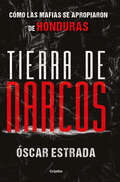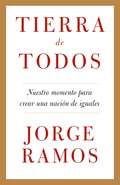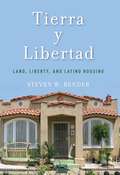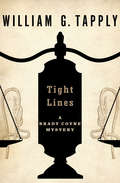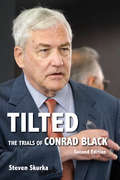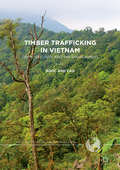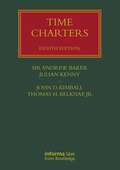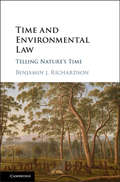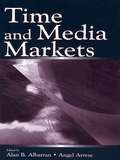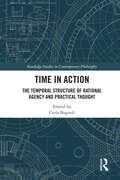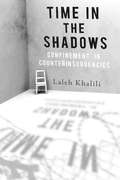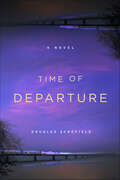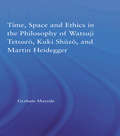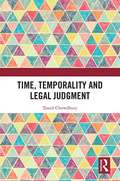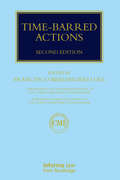- Table View
- List View
Tiergestützte Interventionen im Justizvollzug
by Sandra Wesenberg Lena Scheidig Frank NestmannIn diesem Band werden erstmals auf wissenschaftlicher Basis die Möglichkeiten tiergestützter Interventionen im Strafvollzug ausgeleuchtet. Verschiedene Forschungsprojekte und Best-Practice-Beispiele aus Deutschland, Österreich, Frankreich, Italien, Luxemburg und der Schweiz geben Auskunft über Gelingensbedingungen und erfolgreiche Strategien wie auch Hindernisse und Grenzen tiergestützter Arbeit im Jugendarrest, in Justizvollzuganstalten oder in forensischen Kliniken. Die verschiedenen Beiträge zeigen eindrücklich, wie der Einbezug von Hunden, Pferden, Eseln oder Hühnern die Resozialisierung von jugendlichen wie erwachsenen Inhaftierten befördern kann.
Tiermisshandlungen im Kindes- und Jugendalter: Eine qualitative Analyse zu pädagogischer Anamnese, Diagnostik und Interventionsstrategien
by Blanca HommaDas Thema Tierquälerei ist im deutschsprachigen Raum wissenschaftlich kaum untersucht. In dem vorliegenden Buch wird der Fachdiskurs zu Hintergründen von Tiermisshandlungen im Kindes- und Jugendalter näher beleuchtet, indem Theorien herangezogen werden und der internationale Forschungsstand rekapituliert wird. Als Ergebnis einer qualitativen Analyse werden anschließend Erfahrungen von Fachkräften der Kinder- und Jugendhilfe geschildert, die ihre Falleinschätzungen und Handlungsoptionen beschreiben. Mit vier Fallgeschichten wird die Annahme der Autorin gestützt, dass zwischen vier verschiedenen Formen der Tiermisshandlungen unterschieden werden kann.
Tierra de narcos: Cómo las mafias se apropiaron de Honduras
by Oscar EstradaLa más impactante y controversial investigación periodística de los últimos veinte años en Honduras. "Tierra de narcos, la más impactante y controversial investigación periodística de los últimos veinte años en Honduras, ha significado una sacudida estremecedora para varios estamentos del poder en ese país. La develación de secretos ocultos tras las bambalinas sociales, en voz de uno de sus protagonistas, muestra la profunda corrupción y abuso de poder en las que se precipitan instituciones y gobiernos enteros ante la tentación de las ganancias ilícitas del narcotráfico. Esta obra es el espejo en donde muchos estados de nuestra región deberían mirarse." -Javier Suazo Mejía. novelista y cineasta hondureño "Ésta es una historia real y, ahora, una obra de referencia muy necesaria que muestra con detalle cómo los narcos fueron ganando terreno en Honduras, cómo la supuesta guerra contra las drogas ha provocado que la violencia aumente exponencialmente, ensañándose con los más pobres (países y ciudadanos). Nos explica cómo las redes transnacionales del narcotráfico solo pueden ser sostenidas con la ayuda de funcionarios estatales, tanto de Honduras como de Estados Unidos, desde los niveles policiales más bajos hasta los más altos." -Ellen van Damme, criminóloga, Universidad de Leuven, Bélgica "Sin duda Tierra de narcos es un libro eminentemente periodístico, necesario no solo para informar, sino, sobre todo, para generar conciencia en una sociedad polarizada. Los lectores encontrarán respuesta a muchas interrogantes que nos hemos planteado. Sabemos que, como país, Honduras está sumido en un gran dilema y para resolverlo es urgente revisar las estrategias que desde el Estado se ponen en práctica para evitar que la caída del gran cártel de JOH, no traiga como consecuencia la inmediata reagrupación de los demás cárteles." -Aldo Romero, periodista y profesor universitario hondureño
Tierra de todos
by Jorge RamosEstados Unidos es un país que hoy tiene habitantes de primera y de segunda clase. Esto tiene que cambiar, y pronto. Hay 12 millones de indocumentados, pero también hay una esperanza: la promesa que Barack Obama le hizo a Jorge Ramos de que durante su primer año como presidente apoyaría una reforma migratoria. Tierra de todos es un libro urgente y necesario, que pretende ayudar a que se realice esta reforma. Este es un libro que da voz a los que no la tienen. Un libro que todo inmigrante debe tener y, sobre todo, este es un libro que todos los que critican a los inmigrantes deben leer, para que entiendan que Estados Unidos es un mejor país gracias a todas las personas que vinieron de otros países.From the Trade Paperback edition.
Tierra y Libertad: Land, Liberty, and Latino Housing (Citizenship and Migration in the Americas #8)
by Steven W. BenderOne of the quintessential goals of the American Dream is to own land and a home, a place to raise one’s family and prove one’s prosperity. Particularly for immigrant families, home ownership is a way to assimilate into American culture and community. However, Latinos, who make up the country’s largest minority population, have largely been unable to gain this level of inclusion. Instead, they are forced to cling to the fringes of property rights and ownership through overcrowded rentals, transitory living arrangements, and, at best, home acquisitions through subprime lenders.In Tierra y Libertad, Steven W. Bender traces the history of Latinos’ struggle for adequate housing opportunities, from the nineteenth century to today’s anti-immigrant policies and national mortgage crisis. Spanning southwest to northeast, rural to urban, Bender analyzes the legal hurdles that prevent better housing opportunities and offers ways to approach sweeping legal reform. Tierra y Libertad combines historical, cultural, legal, and personal perspectives to document the Latino community’s ongoing struggle to make America home.
Tierwohl durch Genom-Editierung?: Tierethische Perspektiven auf die Genom-Editierung bei landwirtschaftlichen Nutztieren (Techno:Phil – Aktuelle Herausforderungen der Technikphilosophie #8)
by Susanne HiekelDer Einsatz neuer biotechnologischer Verfahren, wie der der Genom-Editierung, hat die Debatte um die ethische Zulässigkeit einer gentechnischen Veränderung von Tieren neu entflammt. Die Motivation zu genomeditorischen Züchtungsvorhaben ist, so wie bei „konventionellen“ Vorhaben auch, zumeist produktions- und leistungsorientiert. Es gibt vereinzelt aber auch Vorhaben, die darauf abzielen, dem tierlichen Wohl zugutezukommen. Dieser Zusammenhang des „Tierwohls durch Genom-Editierung“ wirft einige Forschungsfragen auf: Wodurch sind die Verfahren der Genom-Editierung in der Nutztierzucht überhaupt charakterisiert? Wie lässt sich das Anwendungsspektrum von genomeditorischen Nutztier-Zuchtvorhaben, die das tierliche Wohl befördern sollen, genauer beschreiben? Ist das Wohlergehen „zukünftiger Tiere“ überhaupt von moralischer Relevanz (Problem der Nicht-Identität)? Sind genomeditorische Zuchtvorhaben möglicherweise generell abzulehnen, weil sie die Integrität der betroffenen Tiere verletzen? Wie sind genomeditorische Zuchtvorhaben, die das Wohl von landwirtschaftlichen Nutztieren befördern sollen, aus tierwohltheoretischer Perspektive zu beurteilen? Wie – falls überhaupt – lassen sich Handlungen rechtfertigen, die zwar einerseits zur Perpetuierung einer moralisch problematischen Praxis beitragen, andererseits aber in bestimmter Hinsicht gegenüber dieser problematischen Praxis eine Verbesserung bedeuten? Antworten auf diese Fragen stellt dieses Buch bereit.
Tiger, Tyrant, Bandit, Businessman: Echoes of Counterrevolution from New China
by Brian DeMareThe rural county of Poyang, lying in northern Jiangxi Province, goes largely unmentioned in the annals of modern Chinese history. Yet records from the Public Security Bureau archive hold a treasure trove of data on the every day interactions between locals and the law. Drawing on these largely overlooked resources, Tiger, Tyrant, Bandit, Businessman follows four criminal cases that together uniquely illuminate the dawning years of the People's Republic. Using a unique casefile approach, Brian DeMare recounts stories of a Confucian scholar who found himself allied with bandits and secret society members; a farmer who murdered a cadre; an evil tyrant who exploited religious traditions to avoid prosecution; and a merchant accused of a crime he did not commit. Each case is a tremendous tale, complete with memorable characters, plot twists, and drama. And while all depict the enemies of New China, each also reveals details of village life during this most pivotal moment of recent Chinese history. Together, the narratives bring rural regime change to life, illustrating how the Chinese Communist Party cemented its authority through mass political campaigns, careful legal investigations, and sheer patience. Balancing storytelling with historical inquiry, this book is at once a grassroots view of rural China's legal system and its application to apparent counterrevolutionaries, and a lesson in archival research itself.
Tight Lines (The Brady Coyne Mysteries #11)
by William G. TapplyTo find a dying client&’s wayward daughter, the Boston lawyer combs through the darkest corners of New England in this &“surprising, convincing&” mystery (Publishers Weekly). Concord, Massachusetts, is littered with literary monuments, of which the historic Ames house is only a minor one. But to Susan Ames, nowhere on earth is more important than this colonial residence where Emerson and Thoreau once broke bread with her ancestors. Dying of cancer, Susan knows the house should stay in her family, but the only heir is her daughter, Mary Ellen, a wild child more likely to indulge in cocaine and motorcycles than transcendental poetry. Eleven years ago, she ran off with her college professor, and will need to be located before she can inherit the estate. Finding her falls to Brady Coyne, a good-hearted Boston attorney who knows his way around New England&’s dark parts. He will soon find that Mary Ellen&’s story is too tragic even for a great poet to contemplate.
Tilted: The Trials of Conrad Black, Second Edition
by Steven SkurkaWith the advent of Conrad Black’s new appeal, Steven Skurka is back to deliver a thorough, in-depth account of the controversial businessman’s legal difficulties. It was the trial that captivated observers on both sides of the Atlantic. Media titan Conrad Black, by turns respected and reviled for decades in Canada and around the world, faced off with U.S. prosecutors on charges of criminal fraud stemming from his activities with Hollinger International. As the only Canadian writer to attend the trials of Conrad Black, lawyer Steven Skurka delivers a thorough, in-depth account of the controversial businessman’s legal difficulties. Skurka offers analysis, insights, and personal anecdotes to present the clearest picture of the trials to date, featuring interviews with key members of the prosecution and defence, as well as a peek into the jury room during final deliberations. In the first edition of Tilted, Skurka showed how the prosecution attempted to "tilt" the trial in its favour, but he also demonstrated how Black unsuccessfully attempted to tilt the trial his way. Black lost his appeal to the Court of Appeals and began serving a six-and-a-half-year prison sentence in Florida. Black’s legal battles moved to the U.S. Supreme Court, followed by a second appeal in Chicago and leading eventually to a dramatic conclusion. Now Skurka brings the reader up to date on all of the recent developments in Conrad Black’s case, including new interviews and behind the scenes strategy.
Timber Design (Architect's Guidebooks to Structures)
by Paul W. McMullin Jonathan S. PriceTimber Design covers timber fundamentals for students and professional architects and engineers, such as tension elements, flexural elements, shear and torsion, compression elements, connections, and lateral design. As part of the Architect’s Guidebooks to Structures series, it provides a comprehensive overview using both imperial and metric units of measurement. Timber Design begins with an intriguing case study and uses a range of examples and visual aids, including more than 200 figures, to illustrate key concepts. As a compact summary of fundamental ideas, it is ideal for anyone needing a quick guide to timber design.
Timber Trafficking in Vietnam: Crime, Security and the Environment (Palgrave Studies in Green Criminology)
by Ngoc Anh CaoThis book is the first systematic investigation into the problem of timber trafficking in Vietnam, providing a detailed understanding of the typology of, victimization from, and key factors driving this crime. The book first reveals a multifaceted pattern of timber trafficking in Vietnam, comprising five different components: harvesting, transporting, trading, supporting, and processing. It then assesses the crime’s victimization from timber trafficking. Thanks to the employment of a broad conceptual framework of human security, Cao reveals that timber trafficking has substantial harmful impacts on all seven elements of human security: economic, food, health, environmental, personal, community, and political; whilst being closely interconnected, they vary between different groups of victims. Cao concludes by offering five solutions to better control of timber trafficking in the context of Vietnam, which crucially involve refining the current policy framework of forest governance and improving the efficiency of law enforcement. A wide-ranging and timely study, this book will hold particular appeal for scholars of green criminology and environmental harm.
Time Charters (Lloyd's Shipping Law Library)
by Andrew Baker Julian Kenny John Kimball Thomas H. Belknap JrAcclaimed as the standard reference work on the law relating to time charters, this new edition provides a comprehensive treatment of the subject, accessible and useful both to shipping lawyers and to shipowners, charterers, P&I Clubs and other insurers. It provides full coverage of both English and U.S. law, now updated with all the important decisions since the previous edition. The English decisions covered in the new edition include: The Kos (the Supreme Court on the effect of withdrawing a ship with cargo on board); The Athena (nature of off-hire; meaning of 'loss of time’/'time thereby lost'); The Kyla (damage to ship and frustration); The Silver Constellation, The Savina Caylyn and The Rowan (oil company approval of chartered ships); The Captain Stefanos, The Saldanha, The Triton Lark and The Paiwan Wisdom (effects of piracy); The Kildare and The Wren (damages for early termination); The T S Singapore (off-hire where ship going 'towards but not to' the port ordered), and The Lehmann Timber, The Bulk Chile and The Western Moscow (owners' liens) The new edition also features many significant new U.S. decisions, including: Stolt-Nielsen v. Animal Feeds Intl. (Supreme Court rules class-action arbitration not permitted unless parties agree in arbitration agreement); ATHOS I (Circuit Court finds that safe berth provision in charterparty is a warranty and not merely a due diligence obligation); The M/V SAMHO DREAM (arbitrators direct petitioner to post $14.2M security on respondent’s counterclaim) and Maroc Fruit Board v. M/V VINSON (CP arbitration clause incorporated in bill of lading not "signed" or "contained in an exchange of letters or telegrams" under NY Convention).
Time Charters (Lloyd's Shipping Law Library)
by Julian Kenny Andrew Baker John D. Kimball Thomas H. Belknap, Jr.Acclaimed as the standard reference work on the law relating to time charters, this new edition provides a comprehensive treatment of the subject, accessible and useful both to shipping lawyers and to shipowners, charterers, P&I Clubs and other insurers. It provides full coverage of both English and U.S. law, now updated with all the important decisions since the previous edition.
Time Limited Interests in Land
by Alain-Laurent Verbeke Cornelius Van Der MerweA comprehensive comparative treatment of six instances of time-limited interests in land as encountered in fourteen European jurisdictions. The survey explores the commercial or social origins of each legal institution concerned and highlights their enforceability against third parties, their content and their role in land development. The commercial purpose of residential and agricultural leases is contrasted with the social aim of personal servitudes (and its common-law equivalent liferent) to provide sustenance for life to mostly family members making the latter an important estate planning device. Whereas the ingrained principles of leases and personal servitudes restrain the full exploitation of land, it is indicated that public authorities and private capital could combine to turn the old-fashioned time-limited institutions of hereditary building lease (superficies) and hereditary land lease (emphyteusis) into pivotal devices in alleviating the acute shortage of social housing and in promoting the fullest exploitation of pristine agricultural land.
Time and Environmental Law: Telling Nature's Time
by Richardson Benjamin J.Disciplined by industrial clock time, modern life distances people from nature's biorhythms such as its ecological, evolutionary, and climatic processes. The law is complicit in numerous ways. It compresses time through 'fast-track' legislation and accelerated resource exploitation. It suffers from temporal inertia, such as 'grandfathering' existing activities that limits the law's responsiveness to changing circumstances. Insouciance about past ecological damage, and neglect of its restoration, are equally serious temporal flaws: we cannot live sustainably while Earth remains degraded and unrepaired. Applying international and interdisciplinary perspectives on these issues, Time and Environmental Law explores how to align law with the ecological 'timescape' and enable humankind to 'tell nature's time'. Lending insight into environmental behaviour and impacts, this book pioneers a new understanding of environmental law for all societies, and makes recommendations for its reform. Minding nature, not the clock, requires regenerating Earth, adapting to its changes, and living more slowly.
Time and Media Markets (Routledge Communication Series)
by Alan B. Albarran Angel Arrese RecaThis edited collection examines time and its relationship to and impact upon media industries, studying how the media industry views time and makes business and economic decisions based on considerations of time. Contributions from an international set of authors analyze time constraints and competition between different media; the quantity and quality of time spent in media consumption, audience and readership time valuation/costing/pricing; and the emergence of new media businesses around individual time management. Specific topics examined in the volume include: * a philosophical look at the concept of time and its application to media markets; * temporal aspects of media distribution for the media industries, and how time affects their activities; * the impact of increasing media industry consolidation and convergence on managerial effectiveness; * approaches to time by CNN and its various cache of news channels, in a managerial context; * the application of niche theory as a framework to examine competition between the Internet and television; * Internet access in the United Kingdom and Europe, examining the cost of time for online access; * the exchange of time and money in the television market for advertising; and * a summary of research and an agenda for future research on the topic of time's role in the media industry and markets. With its origins in the third World Media Economics conference, held in 2000, Time and Media Markets is a distinctive and important collection appropriate for scholars and advanced students in media management and economics.
Time for Solutions!: Overcoming Gender-related Career Barriers
by Susan M. AdamsTime for Solutions! Overcoming Gender-related Career Barriers shares the who, what and how to reduce gender inequalities in the workplace. Clearly the time is now since inequities are hampering the economy and simply wrong. Who needs to change? And, how? These can be more difficult questions to answer. This book identifies a wide range of issues that need attention and provides direction pertaining to who needs to do what. Gender diversity studies have concentrated on the plight of women which unfortunately still needs consideration. We go beyond the problems of women to see what some in the LGBTQ community are facing and what needs to happen to reduce their barriers. Interestingly, there are a few universal solutions that are not complicated to implement. All it takes is paying attention to individual needs and implementing sociological solutions that create long-term inclusion. Of course, the devil is in the details. Authors of this book provide those details.
Time in Action: The Temporal Structure of Rational Agency and Practical Thought (Routledge Studies in Contemporary Philosophy)
by Carla BagnoliThis book explores the role of time in rational agency and practical reasoning. Agents are finite and often operate under severe time constraints. Action takes time and unfolds in time. While time is an ineliminable constituent of our experience of agency, it is both a theoretical and a practical problem to explain whether and how time shapes rational agency and practical thought. The essays in this book are divided into three parts. Part I is devoted to the temporal structure of action and agency, from metaphysical and metaethical perspectives. Part II features essays about the temporal structure of rational deliberation, from the perspective of action theory and theories of practical reasoning. Part III includes essays about the temporal aspects of failures of rationality. Taken together, the essays in this book shed new light on our understanding of the temporality of agency that coheres with our subjective sense of finitude and explains rational agency both in time and over time. Time in Action will be of interest to advanced students and researchers working on the philosophy of time, metaphysics of action, action theory, practical reasoning, ethical theory, moral psychology, and rational justification.
Time in the Babylonian Talmud: Natural and Imagined Times in Jewish Law and Narrative
by Lynn KayeIn this book, Lynn Kaye examines how rabbis of late antiquity thought about time through their legal reasoning and storytelling, and what these insights mean for thinking about time today. <P><P>Providing close readings of legal and narrative texts in the Babylonian Talmud, she compares temporal ideas with related concepts in ancient and modern philosophical texts and in religious traditions from late antique Mesopotamia. Kaye demonstrates that temporal flexibility in the Babylonian Talmud is a means of exploring and resolving legal uncertainties, as well as a tool to tell stories that convey ideas effectively and dramatically. Her book, the first on time in the Talmud, makes accessible complex legal texts and philosophical ideas. It also connects the literature of late antique Judaism with broader theological and philosophical debates about time. Introduces a new method for studying concepts in Talmudic texts, helping others conduct conceptual research in rabbinic and other late antique legal literatures; Connects literature of late antique Judaism with broader theoretical, theological and philosophical debates about time, appealing to readers who are interested in time but are not rabbinic literature specialists; Clarifies complex Hebrew and Aramaic source material, making texts that are understood by relatively few experts more accessible.
Time in the Shadows: Confinement in Counterinsurgencies
by Laleh KhaliliDetention and confinement-of both combatants and large groups of civilians-have become fixtures of asymmetric wars over the course of the last century. Counterinsurgency theoreticians and practitioners explain this dizzying rise of detention camps, internment centers, and enclavisation by arguing that such actions "protect" populations. In this book, Laleh Khalili counters these arguments, telling the story of how this proliferation of concentration camps, strategic hamlets, "security walls," and offshore prisons has come to be. Time in the Shadowsinvestigates the two major liberal counterinsurgencies of our day: Israeli occupation of Palestine and the U. S. War on Terror. In rich detail, the book investigates Abu Ghraib, Guantánamo Bay, CIA black sites, the Khiam Prison, and Gaza, among others, and links them to a history of colonial counterinsurgencies from the Boer War and the U. S. Indian wars, to Vietnam, the British small wars in Malaya, Kenya, Aden and Cyprus, and the French pacification of Indochina and Algeria. Khalili deftly demonstrates that whatever the form of incarceration-visible or invisible, offshore or inland, containing combatants or civilians-liberal states have consistently acted illiberally in their counterinsurgency confinements. As our tactics of war have shifted beyond slaughter to elaborate systems of detention, liberal states have warmed to the pursuit of asymmetric wars. Ultimately, Khalili confirms that as tactics of counterinsurgency have been rendered more "humane," they have also increasingly encouraged policymakers to willingly choose to wage wars.
Time of Departure: A Novel
by Douglas SchofieldFull of spellbinding twists, Douglas Schofield's Time of Departure will appeal not only to thriller aficionados, but to readers who appreciate a strong female lead and a compelling love story. A page-turner that will keep readers on the edge of their seats, Time of Departure heralds the arrival of an immensely talented new crime novelist.Florida state prosecutor Claire Talbot is as tough as they come, and not everyone loves her for it. Newly promoted Felony Division Chief, Claire has about as many jealous detractors as she does supporters. Some colleagues are openly skeptical about her youth, her abilities, and even her gender. When a highway project construction crew unearths two skeletons in a common grave, Claire reopens an investigation into a string of abductions that took place before she was born. While researching the file, she meets retired cop Marc Hastings, who once worked on the case. He maneuvers his way into the investigation-and into Claire's life. Marc has an uncanny familiarity with Claire's habits, and she begins to realize that not all is as it seems. The detective urges Claire on, mysteriously convinced that only she can solve the case. Together, they unearth more graves. But then, disaster strikes ... and Claire finally discovers what Hastings knew all along. It's a secret almost too shocking for a sane mind to grasp. The key to the killings may lie deep in Claire's own past. But what if Claire's past lies in her future?
Time, Love, Memory: A Great Biologist and His Quest for the Origins of Behavior
by Jonathan WeinerJonathan Weiner brings his skills to the story of Benzer, the Brooklyn-born maverick scientist whose study of genetics and experiments with fruit fly genes has helped revolutionize the connections between DNA and behavior both animal and human.
Time, Space, and Ethics in the Thought of Martin Heidegger, Watsuji Tetsuro, and Kuki Shuzo
by Graham MayedaIn this book, Graham Mayeda demonstrates how Watsuji Tetsuro and Kuki Shuzo, two twentieth-century Japanese philosophers, criticize and interpret Heideggerian philosophy, articulating traditional Japanese ethics in a modern idiom.
Time, Temporality and Legal Judgment
by Tanzil ChowdhuryThis book challenges the correspondence theory of judicial fact construction – that legal rules resemble and subsume facts ‘out there’ – and instead provides an account of judicial fact construction through legally produced times- or adjudicative temporalities- that structure legal subject and event formation in legal judgement.Drawing on Bergsonian and Gadamerian theories of time, this book details how certain adjudicative temporalities can produce fully willed and autonomous subjects through ‘time framed’ legal events – in effect, the paradigmatic liberal legal subject – or how alternative adjudicative temporalities may structure legal subjects that are situated and constituted by social structures. The consequences of this novel account of legal judgement are fourfold. The first is that judicial fact construction is not exclusively determined by the legal rule (s) but by adjudication’s production of temporalities. The second is that the selection between different adjudicative temporalities is generally indeterminate, though influenced by wider social structures. As will be argued, social structures, framed as a particular type of past produced by certain adjudicative temporalities, may either be incorporated in the rendering of the legal event or elided. The third is that, with the book’s focus on criminal law, different deployments of adjudicative temporalities effect responsibility ascription. Finally, it is argued that the demystification of time as that which structures event and subject formation reveals another way in which to uncover the politics of legal judgement and the potential for its transformative potential, through either its inclusion or its elision of social structures in adjudication’s determination of facts.This book will be of interest to students and scholars in the field of legal judgement, legal theory and jurisprudence.
Time-barred Actions
by Francesco BerlingieriA book which sets out the latest national law relating to time bars on the most common maritime claims in over 30 countries. It includes new jurisdictions and additional information. It provides the answers to such questions as what is the time-bar period for a particular type of claim, when does a time-bar period for a claim begin, how can the time-bar period be interrupted, extended or ended and what are the consequences of the time-bar period running out?


